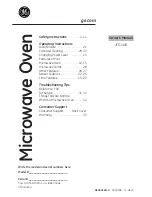
en
Tested for you in our cooking studio
40
Universal pan or baking tray
Slide the universal pan or the baking tray in carefully as
far as the limit stop with the bevelled edge facing the
appliance door.
When baking moist cakes or pastries with many
toppings, use the universal pan so that any excess
liquid does not overflow and make the cooking
compartment dirty.
Baking tins
Dark- coloured metal baking tins are most suitable.
Tinplate baking tins, ceramic dishes and glass dishes
extend baking time and mean that the baked item will
not brown evenly. If you wish to bake using these
baking tins/dishes and using top/bottom heating, slide
in the tin/dish at level 1.
The baking tins must be resistant to heat and steam for
use in steam-assisted baking.
Greaseproof paper
Only use greaseproof paper that is suitable for the
selected temperature. Always cut greaseproof paper to
size.
Recommended setting values
The table lists the optimal heating type for various
baked items. The temperature and baking time depend
on the amount and consistency of the dough/mixture.
For this reason, the table specifies setting ranges. Try
using the lower values to start with. A lower temperature
will result in more even browning. You can use a higher
setting next time if necessary.
Note:
Baking times cannot be reduced by using higher
temperatures. Cakes or small baked items would only
be cooked on the outside, and would not be fully baked
in the middle.
The setting values apply to food that is placed into a
cold cooking compartment; by doing this, you can
make energy savings of up to 20 per cent.If you preheat
the oven, you can reduce the indicated baking times by
several minutes.
Preheating is necessary for selected food, and this is
indicated in the table. Do not place your food or
accessories into the cooking compartment until it has
finished preheating.
If you wish to follow one of your own recipes when
baking, you should use the setting values listed for
similar baked items in the table as reference.Additional
information can be found in the baking tips listed after
the settings table.
Remove unused accessories from the cooking
compartment. This will ensure that you achieve the best
possible cooking results and energy savings of up to
20 per cent.
Types of heating used:
■
:
4D hot air
■
%
Top/bottom heating
■
;
Pizza setting
The levels of steam intensity are indicated as numbers
in the table:
■
1 = Low
■
2 = Medium
■
3 = High
Dish
Accessories/cookware
Shelf po-
sition
Type of
heating
Tempera-
ture in °C
MW power
in watts
Steam in-
tensity
Cooking
time in mins.
One level baking
Victoria sponge cake
2x Ø20 cm tins
2
:
160-170*
-
-
25-30
Victoria sponge cake
2x Ø20 cm tins
2
:
150-160
-
1
25-35
Light fruit cake
high Ø20 cm tin
2
:
140-160
-
-
70-90
Light fruit cake
high Ø20 cm tin
2
:
140-150
-
1
90-100
Light fruit cake
high Ø20 cm tin
1
:
140-150
90
-
50-60
Rich fruit cake
high Ø23 cm tin
2
:
130-150
-
-
150-180
Rich fruit cake
high Ø23 cm tin
1
:
130-140
90
-
80-90
Fruit crumble
flat glass dish
3
:
150-170*
-
-
35-45
Sponge Cake (fatless), 3 eggs springform cake tin Ø26 cm
2
:
160-170*
-
-
25-35
Sponge Cake (fatless), 3 eggs springform cake tin Ø26 cm
2
:
150-160
-
1
10
-
20-25
Sponge flan, 6 eggs
springform cake tin Ø28 cm
2
:
150-170*
-
-
30-50
Sponge flan, 6 eggs
springform cake tin Ø28 cm
2
:
150-160
-
-
1
10
-
30-35
Swiss roll
swiss roll tin
3
:
180-190*
-
-
10-15
Swiss roll
swiss roll tin
3
:
180-190*
-
1
10-15
Fruit Pie
plate Ø20 cm or pie tin
2
;
160-170
-
-
55-65
* Preheat
















































